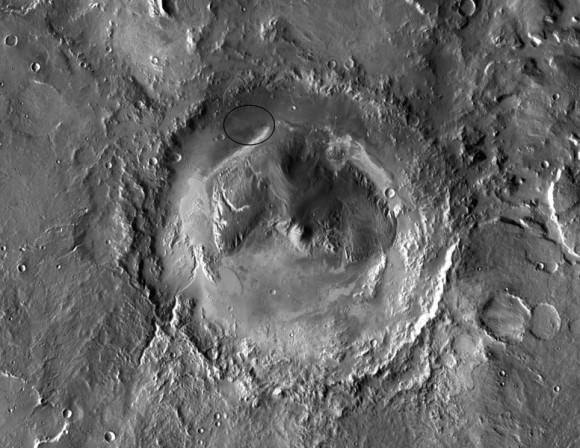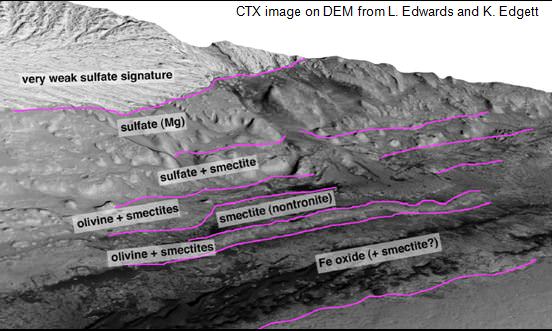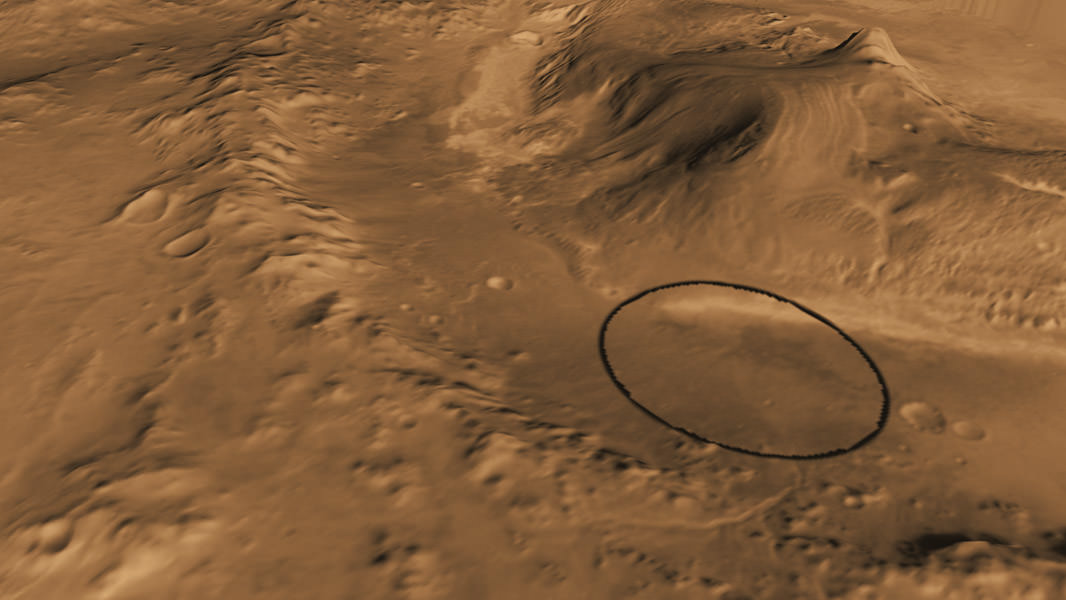[/caption]
It’s official: the Mars Science Laboratory rover, Curiosity, will be landing Gale Crater on Mars. Scientists announced the final decision at a special event at the Smithsonian’s National Air and Space Museum Friday morning. Comparing the terrain to an enticing bowl of layered Neopolitan ice cream, the science team announced the rover will land at the foot of a layered mountain inside Gale Crater.
“The science at Gale is going to be amazing and it will be a beautiful place to visit,” said Dawn Sumner, a geologist with the MSL team.
MSL is scheduled to launch in November 2011 from NASA’s Kennedy Space Center in Florida and land in August 2012. Curiosity is twice as long and more than five times as heavy as previous the Mars Exploration rovers Spirit and Opportunity. The rover will study whether the landing region at Gale crater had favorable environmental conditions for supporting microbial life and for preserving clues about whether life ever existed.
News had leaked out a few weeks ago that Gale was the favored site, but scientists today explained what made Gale stand out among the four final candidates, which each offered their own delicious “flavor,” making the decision a difficult one.

“When it comes down to four landing sites, it comes down to what feels right,” said John Grotzinger, Mars Science Laboratory project scientist. “We as a science team, as a community, we got together and in the end we picked the one that felt best. Why? Here, we’ve got mountain of rocks, taller than Mount Whitney. It looks like Hawaii; it’s not a tall spire, but a broad mound. So we can actually climb up this mountain with the rover. That alone justifies sending the spacecraft there. It turns out, though, the most attractive science sites are at the base of the mountain. We can address the principle goals of the things the Mars community would like answers to.”
NASA’s strategy for Mars has been to “follow the water,” since we know that wherever there is water on Earth, there is life. Scientists are hedging their bets on Mars that wherever liquid water once flowed would be the best places to look for evidence of past habitability.
Gale has that going for it.

The portion of the crater where Curiosity will land has an alluvial fan likely formed by water-carried sediments. The layers at the base of the mountain contain clays and sulfates, both known to form in water.
“It’s a huge crater sitting in a very low-elevation position on Mars, and we all know that water runs downhill,” Grotzinger said. “In terms of the total vertical profile exposed and the low elevation, Gale offers attractions similar to Mars’ famous Valles Marineris, the largest canyon in the solar system.”
The scientists emphasized that MSL is not a life detection mission, as it can’t look for fossils. But it can detect organic carbon, which can tell the early environmental story of Mars, found in the sediments within rocks.
Gale Crater crater spans 154 kilometers (96 miles) in diameter and is about the combined area of Connecticut and Rhode Island. The mound in the center rises 5 km (3 miles) height and the Layering in the mound suggests it is the surviving remnant of an extensive sequence of deposits.
The crater is named for Australian astronomer Walter F. Gale.
About the size of a Mini-Cooper, Curiosity has 17 cameras and a full color video camera. The mission should offer incredible vistas that will likely wow the public, beginning with the landing, as Curiosity will take a full color, high definition movie as it descends on the “Sky Crane” landing system.
Anyone else ready for this mission to get going?


I am glad this phase is over!
Somewhere in the sudden gale of shout outs for the chosen landing site I read that one reason to pick this site is that it is a 3-for-1 package deal.
– The lower horizon is clays, the main target. And at the time Curiosity gets to it, Opportunity should have seen clays too, so there is a connection.
– Then the sulfate horizon. It is interesting in itself and connects with what the other rovers have already looked at.
– Then the likely wind deposited “weak sulfate signature” top layer. Less interest, hard to navigate, but may be warranted as the years add up.
Another good reason I hear is that this, wind filled craters, are common martian features. Some of the landing sites alternatives were one offs, for better or worse. This is a goldilocks choice, somewhat conservative but not entirely (no clear lake signatures, as Eberswalde).
How do you look for fossils? Couldn’t they dig a tiny hole and put a dynamite there? 😀
What fossils might exist on Mars would be microfossils. I don’t think Curiosity is designed to find these, though there is maybe an outside chance. Carrying explosives to Mars is probably not going to be in the cards.
LC
You put out 100 paleontologists in the field, wait one digging season, and if you are lucky one of them have found a fossil.
Or they have found a fossil site, which will give them work for years. The point is that the fossil record is spotty, so they have to try to go for the places where fossils collect and preserve.
There are many types of fossils under the main types of body, trace and geochemical. (See the link above.)
For practical purposes when it comes to microfossils you can, I think (no paleontologist), find them in much the same places. (Say, as carbon isotope traces in carbon residues from fossilized cells.)
For Mars, which had early flowing water, that would be outflows into lakes where clays would settle, trap and preserve unicellular life. That is what Gale is believed to display. At least it has outflows and clays, if not known in the same place as of yet I think. The landing ellipse is smack on a outflow, and the foothills of the center mound are clays.
The main mission of Curiosity is to find organics though; after “follow the water” it is “follow the organics”. This serves to both assess habitability and biological activity if any, current or historical.
I’m a little concerned about the complexity of this landing….
So say we all.
If this flying brick lands on Mars, I will then believe in anything 🙂
If this were a more sensible world, NASA would be given the money to launch enough rovers for every site worth sending them to, and there wouldn’t be the need to whittle the choices down to one.
With the extremely high cost for just 1 rover it would be counter-productive and impractical to build that many rovers for 1 planet. This is why Curiosity is such a large leap forward versus its previous models. The multipurpose capabilities of Curiosity helps to compensate the need to build multiple rovers so scientists can essentially “cover more ground” with a single rover, thus eliminating the need for multi-rover construction. Personally I think NASA needs to be given shuttle funding again. R.I.P. Atlantis, Endeavor, and Discovery.
With the extremely high cost for just 1 rover it would be counter-productive and impractical to build that many rovers for 1 planet. This is why Curiosity is such a large leap forward versus its previous models. The multipurpose capabilities of Curiosity helps to compensate the need to build multiple rovers so scientists can essentially “cover more ground” with a single rover, thus eliminating the need for multi-rover construction. Personally I think NASA needs to be given shuttle funding again. R.I.P. Atlantis, Endeavor, and Discovery.
Funding human spaceflight is a multi-billion waste of money. Let’s use that money to finish the James Webb Space Telescope and the Allen Telescope Array, let’s build a Europa/Ganymede orbiter, a Uranus orbiter and a Mars sample return mission. That would mean a lot more sience per dollar than if we keep sending human meat to space.
Funding human spaceflight is not much for doing science. (Though you can make a good case precisely for paleoanthropology, no robot has ever done that before.)
Human spaceflight would be for exploration, exploitation, colonization. I don’t think colonizing US has ever been claimed to be a waste of money. (A waste of indigenous people’s life though.) Generally such things have paid off plenty.
Does anyone know who is behind the development of the landing system? Is it all NASA engineering or is Armadillo Aerospace involved?
LOL! No, they reuse the back shell from the previous rovers (Curiosity folds differently), the descent profile weights I’m sure (used for passively setting the descent attitude), the parachute type if not size I’m sure,* and the tether from it (that lowered balloon protected rovers).
The development seems to be adding the “sky crane” control system capabilities to the descent stage, and getting rid of the balloons.
—————
* As I hear it, NASA no longer have the financial means to finesse newer chute designs.
Does anyone know who is behind the development of the landing system? Is it all NASA engineering or is Armadillo Aerospace involved?